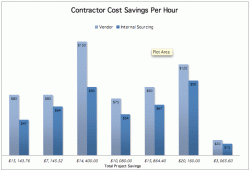Corporate recruiting is lucky.
We are the piece of any corporate HR function that can show our business hard and fast data around spending and savings. We can show you, Mr. Hiring Manager, how much you spent last year per hire, how quickly we filled your need, the quality of those candidates, and exactly where we found them, plus about 37 other data points. Wow. We’re good. Recruiters, not usually a shy bunch, will market our successes to you relentlessly. We run staffing like a business and we like to make sure you get that.
So, how is it that we measure every molecule of a full-time hire, and continue to drive down cost per hire, but know little about the “other” side of staffing. I present to you contractors. Shady sort. And a little scary, if you remember the Microsoft fiasco a few years ago. Co-employment is not your friend. This uneasy feeling may have something to do with our lack of touch on them, or their price tag. But, you can’t really run a business without them.
It used to be that once a contractor requisition was approved, it was automatically distributed to our vendors. We chose these vendors based on information they provided that they (a) could provide us the best rates while (b) guaranteeing excellent quality ( c) from their “unique” databases where they’d have access to people no one else could find. Cool. Except that we spent $7M last year on contractors. Not cool.
Markups (% over pay rate) on contract labor are insane. Particularly in the IT market, we saw our markups sometimes upward of 110%. We began to ask questions of our contractors, like how they decided which agency to sign up with, how much they were paid, and how their interview process went. Even whether they had actually submitted references and background checks. Imagine my surprise!
What I learned is that unique databases are like snipe hunting. The cool kids know they don’t really exist, but they get a kick out of telling people they do. I, apparently, was not one of the cool kids. With a few exceptions, contractors sign up with a variety of agencies. Some contractors never even meet their agency recruiters. They are often submitted without even knowing it. They are not paid nearly as high as you might think, based on the exorbitant cost for their service. Also, for you non~agency folks like me, there is something called a “time stamp.”. When one of my vendors and I found the same candidate for a high end project-management role, he actually challenged whether I had found her “first” and asked for an email with a time stamp on it. Seriously.
Also, contractors are not like normal people. They’re contractors because they want to be contractors. They make more money than us corporate types, and they don’t like the strings attached. They are here to build their resume. Most of them aren’t really interested in full-time roles. They speak differently; they like to be kept “warm.” They need to know you care. The candidate development portion of this process is far moret hands on than it is with full-timers.
With no real guidelines, or benchmark data to use, we at Emdeon did research and used our best HR judgments. I like to stay on the good side of the OFCCP and the EEO, so we took great pains to do this correctly. We hired a payrolling firm. Payrolling firms are the contractor’s W-2 employer and cover all associated taxes.
Then, we began to source candidates, just as we would with a full-time opening.
We provided the candidates with their payrolling firm’s application, via email. Interviews are conducted by our managers. Offers are extended by the payrolling firm. The payrolling firm manages their onboarding and all communications with the contractor. The savings is recognized quickly. Payrolling services are 17% as opposed to the aforementioned 110%.
Track the savings by each open position. The savings are calculated by what the cost per hour would have been if a vendor provided the candidate.
A real example:
Java Programmer for a 200-hour project.
Agency cost 95$ per hour = $19,000.00
Vs
Insourcing Costs $52 per hour = 10,400.00
So, a savings of $8,600.00 is quickly found.
As you can see, if you multiply this by 50 contractors, this is a very effective cost-saving strategy. Using this model, in three months’ time, we saved our business $170,000. We got a lot of attention for that. An actual example (not the complete savings) of some of what we saved is shown in the graph (click to enlarge).
We did find some potholes along the way. To find ethically sound solutions, we worked with our vendors on these.
Q. How do we build a pipeline?
A. You don’t need one. They don’t stay available long enough.
Q. How long does a contractor need to be gone from our company, before we approach him to come back, thereby going “around” the agency?
A. One year.
Q. Can we recruit contractors working at other companies, for our vendors?
A. Yes. If they are on line, they are fair game.
Q. Can we ask our contractors for referrals?
A. Yes. That’s how it works.
In an environment that constantly demands improvements and savings, this is a model that can help you achieve your goals this year.
Contributing Author: Anne Wallbrech